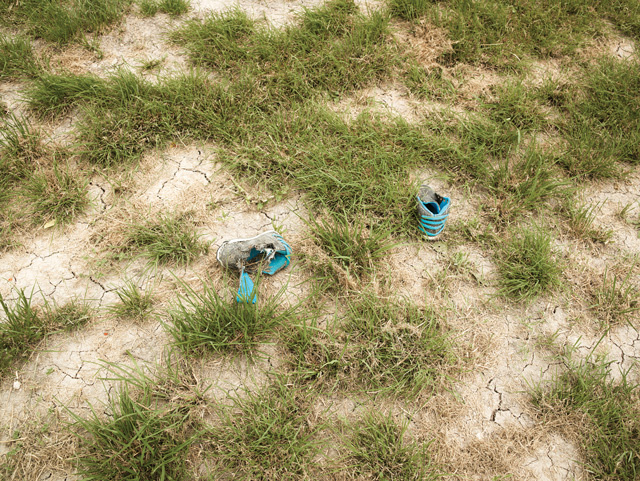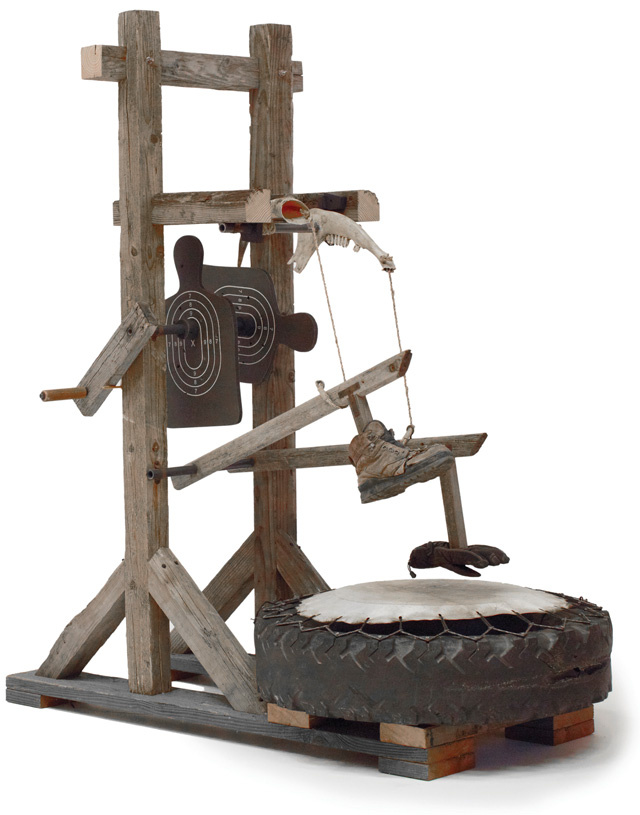Measures of Time: Richard Misrach and Guillermo Galindo
“We are constantly drawing the world together in terms of resemblances and recastings,” noted writer Rebecca Solnit. “And it is the job of artists to draw the lines anew to startle us, wake us up, see the secret route there or where we’ve always been.”1 In their collaborative project Border Cantos, photographer Richard Misrach and avant-garde composer Guillermo Galindo reframe mainstream discussions and media coverage of US-Mexico border issues by giving presence to the thousands of undocumented individuals who cross into the United States each year.
Their collaboration developed after a chance encounter at a Pop-Up Magazine event in San Francisco in November 2011 when Misrach watched Galindo perform an original composition for ingenious instruments he created from objects found at the border. The concert was accompanied by a spoken-word piece by the poet Daniel Alarcon. Misrach remembers shivering when he heard Galindo’s performance: he saw and felt the resonance between his burgeoning photographic project on the border and Galindo’s music.2
By early 2012, Misrach and Galindo had developed their artistic processes with one another and merged their respective media. As Galindo observed, “Richard’s photographs [became] music and my music materialized in his images. At this point, one thing cannot exist without the other.”3 In their shared project, the artists offer a provocative response to the physical and mental divide between the United States and Mexico—a historically contested border that continues to generate polarized discussions about the political limits of the nation-state, the security of national boundaries, and individual freedom.
Every photograph is a measure of time.
—Richard Misrach4
Whether on the beaches of Hawaii, in the scorched hills of Oakland, California, or in New Orleans during the aftermath of Hurricane Katrina, Richard Misrach has always been interested in what he calls “traces of the future”: objects whose meanings are not clear when he photographs them but that emerge over time.5 “It all plays out in the landscape,” explained Misrach. “I look at the bigger picture over time and how the landscape speaks to us.”6 Though his expansive photographs of the American West may recall the work of eminent nineteenth-century American landscape photographers Timothy O’Sullivan (1840 – 1882) and Carleton Watkins (1829 – 1916), Misrach’s practice follows in the tradition of Ansel Adams and Edward Weston, whose twentieth-century landscapes are as much about the beauty of nature as they are about the politics of land use. Yet, unlike his predecessors, Misrach deals with issues of color and scale, enveloping his viewers in a gorgeous visual language in order to convey the tragedies of our time. In solitude, Misrach roams the landscape searching out things that are hidden in plain sight: desecration of public land in Carson Sink, Nevada, from illegal military nuclear tests; relics of the environmental disaster in the 1970s caused by a decade of flooding at the Salton Sea, California; ecological effects of toxic waste dumping in the Mississippi River industrial corridor between Baton Rouge, Louisiana, and New Orleans. Since 1979, Misrach has photographed devastating changes to the American desert as a result of human development and ecological degradation. Collectively, these images comprise The Desert Cantos, the photographer’s long-running and most ambitious project. His work on the US-Mexico border is a subset of this ongoing enterprise.
Misrach began photographing the 1,969-mile border between the United States and Mexico in 2004, and most extensively since 2009 when he noticed increased military-style policing and surveillance, prompted largely by the refortification and expansion of the border fence. He sees the region and its multibillion-dollar corrugated steel barrier as a place where politics and cultures collide in fractious and often tragic ways. Misrach has photographed the entire length of the border and has captured the diverse styles of the fence as it cuts through empty desert, grassland, and rugged mountain passes. Since he began collaborating with Galindo, he has turned his revelatory lens on the varied, mutually dependent communities of the borderlands and focused on found objects that reveal traces of human journeys through the desert landscape.
In early 2014, Misrach was roaming the borderlands near Brownsville, Texas, when he noticed a “trace of the future”: children’s belongings littering the arid landscape. Puzzled, he photographed and collected these objects only to realize several months later the implications of his findings. That summer, news broke about the surge of unaccompanied minors migrating to the United States since the winter of 2013. During this period, the US Customs and Border Protection agency apprehended 52,193 children, representing a 99% increase from the previous year.7 Suddenly, Misrach’s relatively straightforward images of a toddler’s blue velcro-strapped shoes, a girl’s tweezers, and a backpack containing a small lipstick compact found scattered throughout the desert became haunting and somber portraits of young, vulnerable human lives.
[My] music is an imaginary story that each object has and carries within itself.
— Guillermo Galindo8
Guillermo Galindo, who is of Mexican heritage, blends the avant-garde musical traditions of John Cage, Morton Feldman, and Karlheinz Stockhausen with a deep sensitivity to contemporary cultural and political events, particularly those pertaining to the US-Mexico border. He began collecting found objects in Laredo, Texas, where he found a child’s backpack adorned with his son’s favorite cartoon character. “It really touched me that a boy my son’s age was out there going through all of this with his backpack.”9 Galindo considers the instruments he constructs from abandoned possessions sacred because they embody the spiritual and animistic essence of their former owners, recalling musical traditions practiced by many indigenous cultures throughout the world. “In the Pre-Columbian world, there’s an intimate connection between an instrument and the material world from which it is made,” noted Galindo. “All [my] instruments take their inspiration from that idea.”10
Galindo’s meeting with Misrach in 2011 was fortuitous: in light of the ever changing political landscape of the US-Mexico border, Galindo had stopped making regular trips to the region to collect found objects to create his musical sculptures. “Since I am Mexican, I got in more trouble wandering around the border than Richard,” noted Galindo.11 As Misrach explained, “Because I am a white guy with blue eyes, I can be there [at the border] and work. If Guillermo goes, it can be really unpleasant.”12 Both men recognized themselves in the other through difference, yet it is their similarities that link and bind these two artists and their work. “I have begun to think of the camera as a metronome,” noted Misrach.13
Always interested in the tension between the sublime aspects of nature and human intervention in the landscape, Misrach photographs what cannot readily be seen, essentially creating a “found object laden with meaning.”14 In the borderlands, he photographed cast-off objects in situ and then shipped them back to Galindo in Oakland, California. The composer transformed these scavenged items into instruments inspired by a range of indigenous and non-Western musical traditions from around the world: a discarded food can becomes the resonating chamber of an instrument modeled on a single-string Chinese erhu; empty shotgun shells strung together create a variation of the West African shekere, a gourd usually covered with a net of woven beads or seashells.
In combination, the photographs and instruments propose distinct, yet highly interrelated ways of bearing witness to the human consequences presented by the policing of the border, the building of a fence, and hotly disputed immigration policies. Galindo’s instruments and musical compositions literally and metaphorically amplify and embody Misrach’s haunting photographs of hostile landscapes and abandoned possessions.
Upon returning from the borderlands in early 2014, Misrach gave Galindo the children’s items he had found. The composer reimagined these abandoned objects into a “micro-orchestra,” drawing out their potential sounds by rolling, tapping, scraping, scratching, rubbing, and scrunching each of them against wood, metal, and body surfaces. He focused on sounds “that we don’t ordinarily hear and don’t ordinarily think of as music”15 and amplified them with sensitive contact microphones. The delicate, mysterious, cumulative effects embody the harrowing journey these children faced crossing the border into the United States.
*****
Borders shift, expand, contract, rise, and fall all the time. They exist everywhere, from the microscopic to the monumental and from the physical to the psychological. We carry borders with us wherever we go. Sometimes, they are kept hidden. At other times, they are revealed in the ways we look, the places we travel, the languages we speak, and the foods we eat. Borders contain, rather than protect; cause discord rather than unity. As Solnit observed, the border between the United States and Mexico represents “a line across which memory may not travel, empathy may be confiscated, truth held up indefinitely, meaning lost in translation.”16 Misrach and Galindo honor the memory of migrants and lives lost to the desert borderlands. They show us the affinities that bind us together to rouse empathy and reflection. They reveal the realities of the border and the communities and environments affected by it. In Border Cantos, meaning develops over time as image, object, and sound merge in symphonic harmony.
Rory Padeken
assistant curator
NOTES
1. Rebecca Solnit, “Drawing Constellations,” in Storming the Gates of Paradise: Landscapes for Politics
(Berkeley: University of California Press, 2007), 166.
2. Richard Misrach quoted in “Border Signs,” The California Sunday Magazine, November 2, 2014, 36.
3. Guillermo Galindo quoted in “Border Signs,” 36.
4. Richard Misrach quoted in John Guida and Sara Barrett, “Click Here for the Beach,” The New York
Times, May 5, 2015, http://takingnote.blogs.nytimes.com/2015/05/05/click-here-for-the-beach….
5. Misrach in “Border Signs,” 26.
6. Richard Misrach quoted in Eleanor Morgan, “Shoes, Books, Bullets and Backpacks – Every Found
Object On the Mexican Border Represents a Tragedy,” Vice, December 9, 2014,
http://www.vice.com/read/found-objects-along-the-mexican-border-become-….
7. Hannah Rappleye, “Undocumented and Unaccompanied: Facts, Figures on Children at the Border,”
NBC News, July 9, 2014, http://www.nbcnews.com/storyline/immigration-border-crisis/un
documented-unaccompanied-facts-figures-children-border-n152221.
8. Guillermo Galindo quoted in Gabe Meline, “Along the U.S.-Mexico Border, an Unlikely Music is Born,”
KQED Arts, February 4, 2016, http://ww2.kqed.org/arts/2016/02/04/guillermo-galindo-bor
der-cantos-instruments-interview/.
9. Galindo in Morgan.
10. Galindo in “Border Signs,” 36.
11. Galindo in Meline.
12. Misrach in Morgan.
13. Misrach in Guida and Barrett.
14. Misrach in “Border Signs,” 26.
15. Galindo in “Border Signs,” 36.
16. Rebecca Solnit, “Thirty-Nine Steps Across the Border and Back,” in Storming the Gates of Paradise:
Landscapes for Politics, 79.



